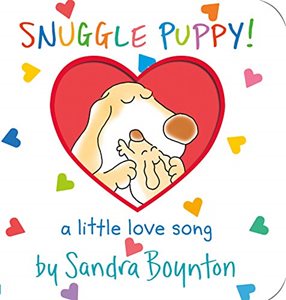This month's Book Nook topic is...
Building Print Knowledge with Snuggle Puppy!

Before a child learns to read and write, they first need to recognize that those funny looking symbols on the page are actually words that convey meaning. When you draw a child’s attention to print and help them make these connections, you are building their print knowledge. In this Book Nook, we will share research-based strategies for building children’s print knowledge by helping them understand the specific way that books and print are used.
Read on for tips to help children understand the meaning behind the print!
The Book:
Snuggle Puppy by Sandra Boynton
Why we chose this book
Snuggle Puppy! is a rewarding story about expressing love to a child. It has a repetitive “chorus” that can be sung or said with intonation. This little board book is also filled with bold, colorful text that jumps out to readers and really is part of the story! For example, you could point out and comment on the colorful string of ‘o’s on one page. The book’s use of different colors and sizes of print offer fun and engaging opportunities for you to help young readers connect the text to the story.
POP: A Key strategy to build print knowledge
Children may sometimes focus on the illustrations and ignore the print while reading stories together. POP is one of Hanen’s key strategies to help children first notice text, and build on their print knowledge. POP stands for Point Out Print. You can POP during reading to draw aspects of print to a child’s attention.
The first reading
The first time you read the book, it is best to keep the flow going. You can track the words with your finger as you say them to help your child connect what you are saying with the symbols on the page. You could add a short comment like “I’m reading these words and they are telling me the story”. You can also make comments as you read that highlight how books are used and that show print is meaningful. For example:
- “Here is the front of the book. This is where the story begins.”
- “Here is the name of the person who wrote the book. She is the author; her name is Sandra Boynton”.
- “We need to read from the front to the back of the book, let’s open it and begin with the first page.”
The second and third readings
Once your child is more familiar with the story, you can pause during reading to use a few more POP strategies We suggest introducing up to 3 print ideas each time you read a book. We want to be mindful not to overwhelm the child with too many interruptions as they may lose interest in the story. Here are a few of the ways you can POP with Snuggle Puppy! during the second and third readings:
- Show and explain how we read from top to bottom and left to right – You can point and say, “I need to start reading here at the top and on this side of the page”.
- Point out upper-case and lower-case letters – “Wow, this whole page is printed in upper-case letters. I think this shows us that he is speaking loudly ”.
- Explain the meaning of punctuation – “There is a period here after the word “you”. That means it is the end of this sentence.”
- Draw attention to text by making comments – “I like how these letters are not straight. They curve upward and go around the puppies”.
- Draw attention to text by pointing out a specific letter at the beginning of a word – “ ‘M’ is the first letter in that word” or ask the child to find a word that starts with the first letter of their name.
Using POP beyond books
You can also use the POP strategy during many other daily activities such as pointing out letters on the cereal box during breakfast or words on your child’s clothing while getting dressed. You can ask them questions about words on products while grocery shopping or talk about print that you see while driving. The more opportunities the child has to explore print, the more their print knowledge will grow!
Happy Reading!
More Resources
The strategies in this Book Nook post are drawn from Hanen’s practical, research-based guidebooks for building emergent literacy. Explore the links below to learn more about how these guidebooks can support you.
For Parents I'm Ready! guidebook
I'm Ready! guidebook
For Educators ABC and Beyond guidebook
ABC and Beyond guidebook
